Cardinal tetra (lat. Paracheirodon axelrodi) are amazingly beautiful fishes and they are the most popular ones in aquarium husbandry. The most of the fish beauty can be seen in the fish school – in a thickly planted tank such a school looks especially glamorous. It’s important to note that cardinal tetras are delicate fish that require proper care and attention. Providing a suitable environment with appropriate tank mates, water conditions, and diet will help ensure their well-being and vibrant colors.
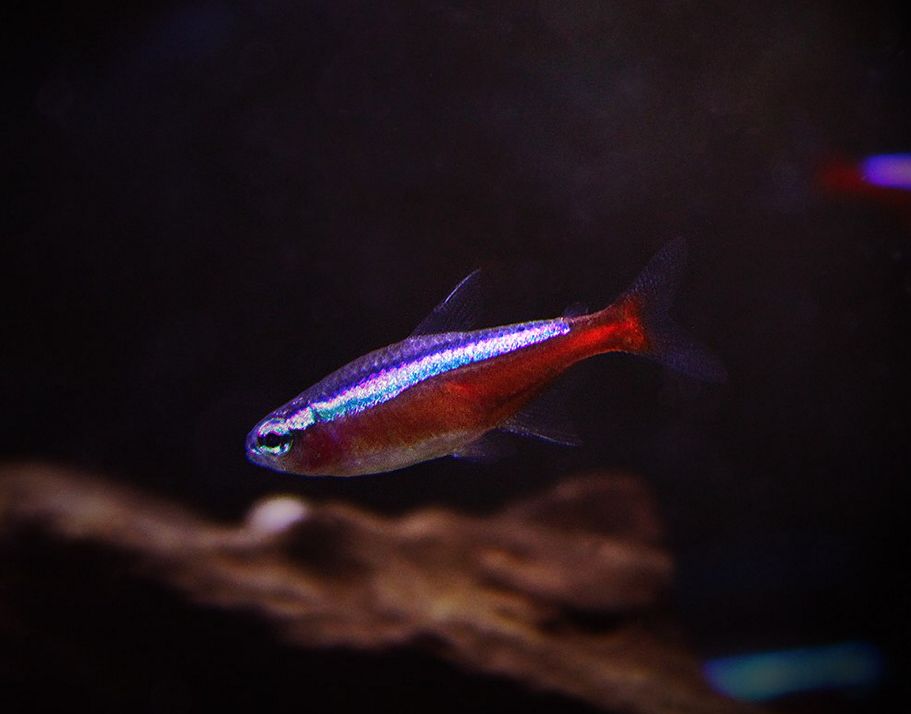
Contents
Habitat in the wild
Cardinal tetra (lat. Paracheirodon axelrodi, Schlutz, 1956) is one of three representatives of Paracheirodon genus, that includes neon tetra (Paracheirodon innesi, Myers, 1936) and green neon tetra (Paracheirodon simulans, Géry, 1963).
Cardinal tetras (Paracheirodon axelrodi) are native to the Amazon River basin in South America. In the wild these schooling fishes inhabit in the middle water layers of flooded forests and tributaries of the river Orinoco and Rio-Negro middle and upper basin. Huge overflow lands appear there during the annual flood rise and cardinal tetra just like many other fishes use these areas for feeding, breeding and shelter. Since the floods begin tetras migrate upstream from the river tributaries to overflow lands and they come back only for the dry season.
In their natural habitat, cardinal tetras inhabit densely vegetated areas, including flooded forest floors and shallow, shaded areas near the riverbanks. These areas often have a lot of fallen leaves and branches, creating a dark and acidic environment. The river “black water” is called so because the rotting plants evolve tannin into the water and it colors the water into dark brown (brew color).
As a result of high organic load the water has specific composition and properties. Inhabit in water with temperature +23…+27 °C and hardness dH = 5—12°. The water in their natural habitat is typically soft and acidic, with a pH range of 5.0 to 6.5.
Description
Color
Cardinal tetras are small and have a vibrant, eye-catching coloration. The cardinal tetra back is olive and beige, it has a neon opalescent bright-blue stripe that goes from its eye to the flesh fin, below this stripe there’s a wide bright-red stripe, the lower half of their body is silver.
Size
How big do cardinal tetras get?
Cardinal tetras are relatively small fish. On average, they grow to about 1.5 inches (3.8 centimeters) in length. Males are usually slightly smaller and more slender than females. Individual sizes can vary, but cardinal tetras generally stay within this size range.
Lifespan
How long do cardinal tetras live?
Cardinal tetras (Paracheirodon axelrodi) have an average lifespan of about 3 to 5 years in captivity. However, with proper care and optimal conditions, some individuals may live up to 6 years. In the wild, cardinal tetra lifespan doesn’t exceed two years.
| Characteristic | Description |
|---|---|
| Scientific Name | Paracheirodon axelrodi |
| Common Name | Cardinal Tetra |
| Native Range | Amazon River basin in South America |
| Size | Up to 1.5 inches (3.8 cm) in length |
| Coloration | Bright blue body with a red stripe and silver belly |
| Behavior | Schooling, peaceful |
| Water Parameters | Soft, slightly acidic water (pH 5.5-7.0) |
| Temperature | 73°F – 81°F (23°C – 27°C) |
| Diet | Flakes, pellets, live or frozen small foods |
| Breeding | Challenging, egg scatterers |
| Natural Habitat | Slow-moving or stagnant blackwater streams |
| Preferred Habitat | Densely vegetated areas near riverbanks |
| Water Conditions | Soft, acidic water with low light levels |

Cardinal tetra vs neon tetra
The cardinal tetra (Paracheirodon axelrodi) and the neon tetra (Paracheirodon innesi) are both popular freshwater fish species that share similar characteristics and are often compared. While they have some similarities, there are also distinct differences between the two. Here’s a comparison of cardinal tetras and neon tetras:
- First of all they are different fishes, though cardinal tetra is sometimes called red neon tetra.
- Neon tetras can tolerate slightly lower temperatures than cardinal tetras.
- While both have blue bodies with red stripes, the neon tetra’s red stripe only extends halfway, while the cardinal tetra’s stripe reaches the base of its tail
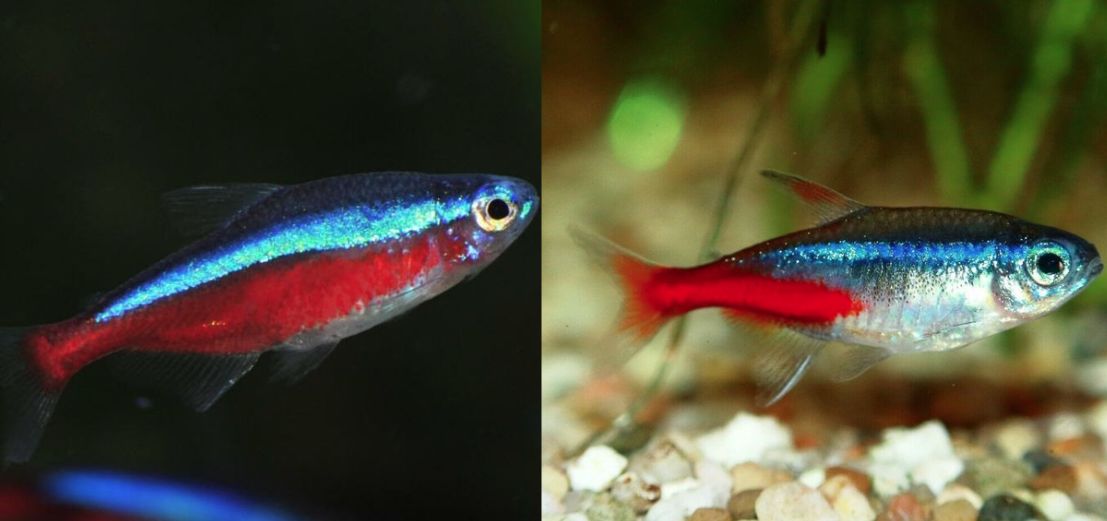
Here’s a comparison table outlining the main differences and similarities between cardinal tetras (Paracheirodon axelrodi) and neon tetras (Paracheirodon innesi):
| Characteristic | Cardinal Tetra | Neon Tetra |
|---|---|---|
| Scientific Name | Paracheirodon axelrodi | Paracheirodon innesi |
| Native Range | Amazon River basin in South America | South America (Brazil, Colombia) |
| Size | Up to 1.5 inches (3.8 cm) in length | Up to 1.5 inches (3.8 cm) in length |
| Coloration | Bright blue body with red stripe | Bright blue body with partial red stripe |
| Red Stripe | Extends from middle to base of tail | Extends halfway from middle of the body |
| Behavior | Schooling, peaceful | Schooling, peaceful |
| Water Parameters | Soft, slightly acidic (pH 5.5-7.0) | Soft, slightly acidic (pH 5.0-7.0) |
| Temperature | 73°F – 81°F (23°C – 27°C) | 70°F – 81°F (21°C – 27°C) |
| Diet | Flakes, pellets, live or frozen foods | Flakes, pellets, live or frozen foods |
| Lifespan | 3-5 years (can live longer with care) | 3-5 years (can live longer with care) |
| Distribution | Broader range in Amazon basin | Limited to Brazil and Colombia |
Difficulties in keeping
Care is rather complicated, since the fish is more demanding than neon. The thing is that cardinal tetra is very sensitive to water parameters and purity, if water parameters are changeable the fish tends to get ill and die. The cardinal tetra is recommended for experienced aquarists, since it rather often dies in a new tank of aquarists beginners
When keeping cardinal in soft and acidic water (black water) the cardinal tetra coloring becomes more bright. Also fish looks quite fascinating in a thickly planted tank with soft lights and dark bottom substrate.
If your tetra inhabits in a tank with stable good conditions, it’ll live for a long time and it’ll resist diseases. But if the tank has unstable changeable conditions, the cardinal tetra dies very quickly. Besides as well as a common neon fish the cardinal tetra is also susceptible to neon tetra disease (NTD).
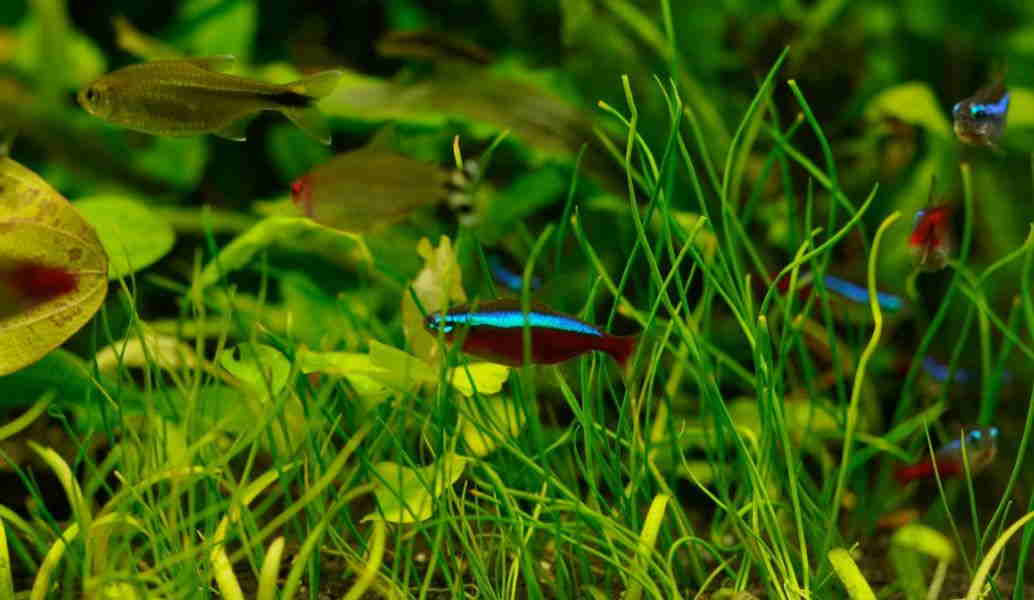
Diet
In the wild, cardinal tetras feed on small insects and other invertebrates. The study of gastrointestinal tract contents of 80 species in the wild showed that they are micropredators. Food consists mainly from zooplankton and blood worm.
The cardinal tetra is easy to feed, it’s not demanding and it eats all types of feed – live, frozen and artificial. They readily accept high-quality flake or pellet food formulated for tropical fish. High-quality flake or pellet foods specifically formulated for tropical fish can serve as the staple diet for cardinal tetras.
It’s important that the feed is small grained, because the cardinal tetra has rather small mouth.
Freeze-dried foods such as daphnia, tubifex worms, or bloodworms can also be offered as occasional treats. These foods retain much of their nutritional value and provide a different texture and taste for the fish.
It’s important to note that a varied diet is crucial to meet the nutritional needs of cardinal tetras. Offering a mix of high-quality flake or pellet foods along with occasional live or frozen foods will help ensure they receive the necessary nutrients. Feed them small amounts multiple times a day, only giving them what they can consume within a few minutes to avoid overfeeding and water quality issues.
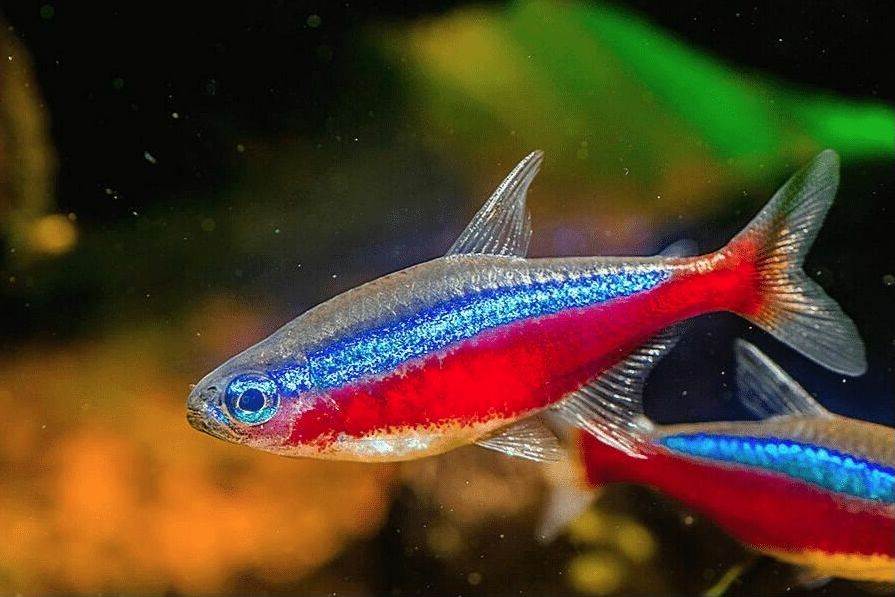
Care and keeping in a tank
Tank size
Cardinal tetra is a schooling, active, and absolutely peaceful fish. You should get about 10 cardinal tetra and more since, in a school of this size, it is more active and less timid. It swims in a school and demonstrates better coloring.
When it comes to tank size, it’s important to consider their active nature and their need for sufficient swimming space. The capacity of a tank may be not large – for a school of 10 cardinal tetra species 10 (38 liters) gallons tank will be enough. However, larger tanks are always better as they offer more swimming space and stability in water parameters. A larger tank also allows for a more natural and visually appealing environment, with room for plants, decor, and other tank inhabitants.
If you plan to keep a larger school of cardinal tetras or include other fish species in the same tank, a larger tank is recommended. As a minimum, a tank size of 20 to 30 gallons (75 to 113 liters) or more is often suggested for a larger school of cardinal tetras or for a community aquarium setup.
The tank should have a lid since the fish is very active and can easily jump out of it.
Water parameters
You must maintain a comfortable water temperature of about 73–81°F (23–27°C). Once a week, you should renew 20% of the tank water. Optimal water parameters for keeping the fish are the following: 73–81°F (23–27°C), pH 6.0-7.0. Cardinal tetras are typically found in soft water conditions. They prefer a low to moderate hardness level, with a recommended range of 1 to 5 dGH (German degrees of hardness) or 18 to 90 ppm (parts per million).
Cardinal tetras are very sensitive to ammonia and nitrates content in the water, so we don’t recommend putting them into newly settled tanks without stable biological balance. When setting up an aquarium for cardinal tetras, it’s a good practice to cycle the tank and establish stable water parameters before introducing the fish. The more stable the water parameters are, the more comfortable it is for the fish.
Tank setup: decorations and plants
The lights should be of moderate intensity with lots of plants in the tank. It’s better to shade that tank with fluctuates. Although the fish needs to have some shelter in the tank, it also needs some open space for swimming.
A thickly planted tank with some free space in the middle will be an ideal one for such a fish. With the help of tank decorations, you can create many shelters.
When decorating the tank, it’s better to make it look natural, i.e., use natural decorations: stones and snags. It’s better to use sand or small pebbles as a tank substate. However, it doesn’t matter much for the fish. Cardinal tetras swim in the middle water layer, and they don’t pick up food from the bottom.
A school of cardinal tetras will look good in a sickly-planted tank. Adding live plants can help create a natural environment and provide hiding places and shade for the fish. Live plants can also contribute to the water chemistry by releasing tannins and lowering the pH slightly. You can put the plants along the back and side walls of the tank and leave a space in the middle for the fish to swim. You can use any popular tank plants: amazon sword, cryptocorynes, hornwort, vallisneria.
Filtration
You should install a filter of proper capacity in the tank, but no strong water flow is needed. It’s better to use a canister filter since bacteria living in it will decompose ammonia and nitrates into less toxic compounds.
Tank mates
Cardinal tetras (Paracheirodon axelrodi) are generally peaceful fish that do well in community aquariums, just like all tetra fishes loves company. It’s desirable to keep a school of 10 species, this is the way they’ll show their best coloring in the tank and also feel comfortable.
Here’s a list of potential tank mates for cardinal tetras:
- Other Peaceful Tetras:
- Neon tetras (Paracheirodon innesi)
- Glowlight tetras (Hemigrammus erythrozonus)
- Ember tetras (Hyphessobrycon amandae)
- Black neon tetra
- Emperor tetra
- Flame tetra
- Red-eyed tetra
- Serpae Tetra
- Rasboras:
- Harlequin rasboras (Trigonostigma heteromorpha)
- Phoenix Rasbora
- Lambchop rasboras (Trigonostigma espei)
- Corydoras Catfish:
- Dwarf Cichlids:
- Apistogramma species (e.g., Apistogramma cacatuoides, Apistogramma agassizii)
- Mikrogeophagus ramirezi (Ram cichlid)
- Small Livebearers:
- Endlers (Poecilia wingei)
- Least killifish (Heterandria formosa)
- Guppies (Poecilia reticulata) (males without long fins to prevent fin nipping)
- Peaceful Dwarf Gouramis:
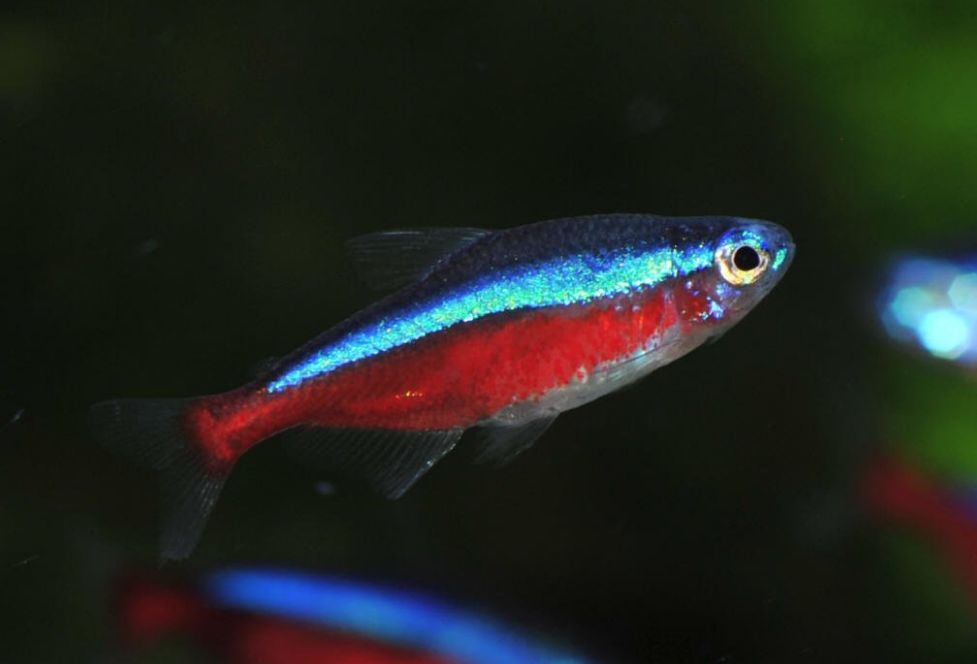
Gender differences: male vs female
Gender dimorphism is very little pronounced as well as of other species of this kind. In general, there are no distinct differences in size, shape, or coloration between male and female cardinal tetras.
When total body size of tetra kept in a tank is 3.5-5 cm (in the wild it’s up to 2.5 cm) the female tends to be larger and fatter than male (especially during their spawning period). During the breeding season, female cardinal tetras may exhibit a slightly rounder belly and a more prominent pink or reddish hue on their lower abdomen.
Breeding
Breeding may be performed both in couples and in school. Usually there 2-3 males for 1 female in a tank. In case of the cardinal tetra couples breeding you may need a tank about 0,5 gallons capacity, if the breeding will be of schooling type the tank capacity should be about 1 gallon.
The water level in a spawning pond should be about 30 cm. Water hardness is 1-2°dH, since if the water is harder the eggs may not get fertilized; pH= 5 – 5,5 and water temperature about 24 -26 °C.
The water should be disinfected by means of ozonizer or ultraviolet lamp. The spawning net and plants with small leaves are put on the tank bottom.
In about a week before the spawning starts it’s desirable to put males apart from females. The cardinal tetra that are to breed are kept in the water with low temperature (about 22 — 23 °C) and fed high and well. You should stop feeding the fishes the day before putting into the spawning pond.
Sometimes the spawning process is delayed for about 5-7 days.
You shouldn’t feed the fishes in the spawning tank , though there’s no sense in keeping them there more than a week. If the eggs weren’t laid during this period of time, you have to remove the fishes from the spawning tank and a few days later try to make them breed again.
The spawning starts when it gets dark and it lasts for several hours. About 300-500 transparent orange eggs appear in the tank during this time.
The tank with eggs should be shaded, since they are very sensitive to light. In 20-36 hours larva appears from the eggs. They start to swim in 5-6 days after that.
As soon as the cardinal tetra juveniles start to swim you should start feeding them. Start feed for juveniles is infusorians and crustaceans nauplii. After you start feeding the juveniles in the tank, you have to start slow aeration of the water.
Also gradually make the water more hard, because it’s necessary for the juveniles. To do this it’s enough to add some water from the community tank into the spawning pond.
As the juveniles grow the start eating feed of larger size. During the first 2 weeks of their lives juveniles hide under the tank plants leaves.
During the 3rd week a blue stripe appears along their body. At about the age of 1 month and a half they have a shape and coloring the same as the adult cardinal tetra has and they can be transferred to the community tank.
Diseases
Cardinal tetras are susceptible to various diseases, as is the case with any aquarium fish. Here are some common diseases that can affect cardinal tetras:
- Neon Tetra Disease (NTD) is a common and highly contagious ailment that affects neon tetras (Paracheirodon innesi) and some other fish species. It is caused by a parasitic microorganism called Pleistophora hyphessobryconis.When fish gets ill, its coloring sharply turns pale. As we already mentioned, sadly, there’s no cure for disease. Once a fish is infected, the prognosis is usually poor, and affected individuals are usually euthanized to prevent further spread of the disease.
- Ich (Ichthyophthirius multifiliis): Ich is a common parasitic disease characterized by white spots on the fish’s body and fins. Affected fish may show signs of scratching against objects in the aquarium. Ich can be treated with medications designed to kill the parasites.
- Fin Rot: Fin rot is a bacterial infection that primarily affects the fins of fish. It can be caused by poor water quality, stress, or injuries. Signs include frayed or eroding fins, and in severe cases, the infection can progress to the fish’s body. Treating fin rot involves improving water conditions and administering appropriate antibiotics.
- Velvet Disease (Oodinium): Velvet is a parasitic disease caused by the Oodinium parasite. Infected fish may exhibit a gold or rusty dust-like coating on their bodies, along with symptoms like rapid breathing and lethargy. Medications specifically designed to treat parasites can be used to combat velvet disease.
- Fungal Infections: Fungal infections can occur when fish have open wounds or injuries that become susceptible to fungal growth. Infected areas may appear fuzzy or cotton-like. Treatment typically involves using antifungal medications and addressing the underlying cause of the infection.
- Bacterial Infections: Cardinal tetras can be prone to various bacterial infections, including columnaris (Flexibacter columnaris) and bacterial septicemia. Symptoms may include open sores, ulcers, red streaks, or swollen body parts. Appropriate antibiotics and improving water quality are essential for treating bacterial infections.
To minimize the risk of diseases, it’s important to maintain good water quality, provide a balanced diet, and avoid overcrowding. Quarantining new fish before introducing them to an established aquarium can also help prevent the spread of diseases. If you notice any signs of illness in your cardinal tetras, it’s best to consult with a knowledgeable aquatic veterinarian or seek advice from experienced fishkeepers to determine the appropriate treatment.